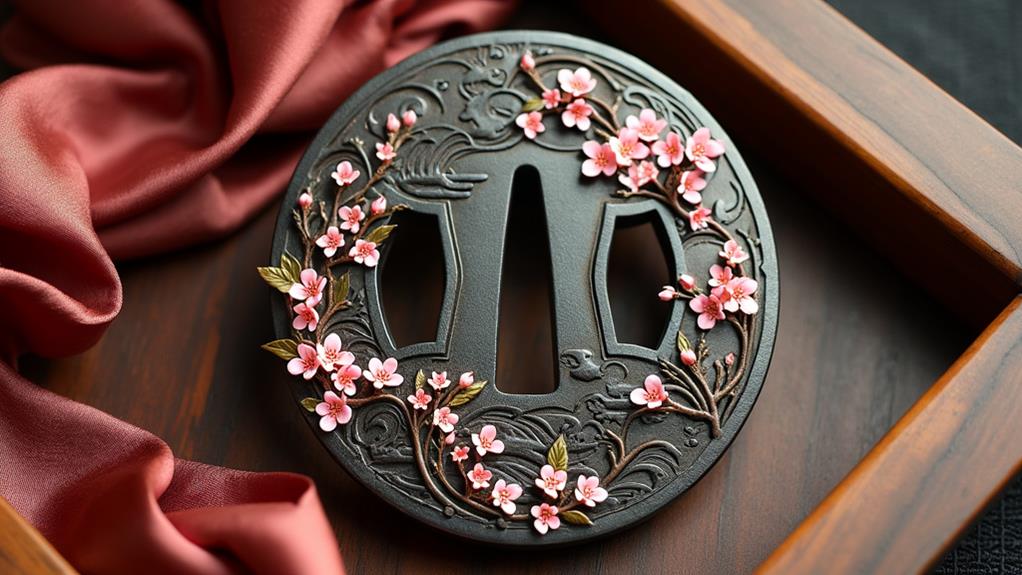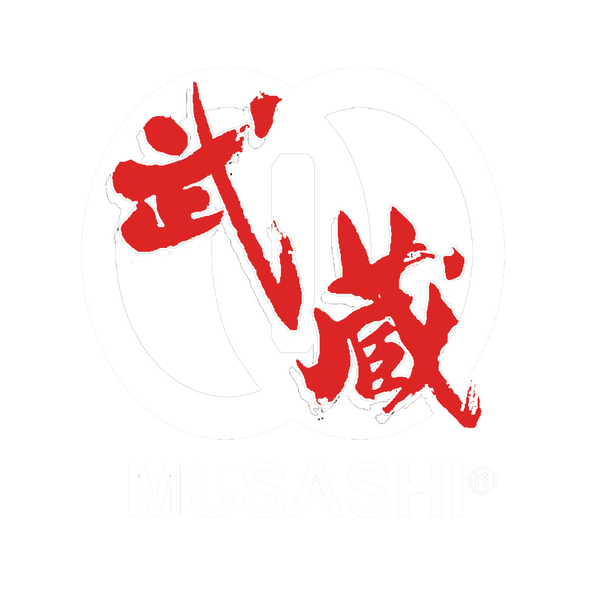
Japanese sword fittings, like the tsuba and menuki, enhance both the beauty and functionality of these iconic blades. The tsuba acts as a protective handguard while showcasing intricate designs. Menuki not only beautifies the grip but improves your hold. Fuchi and kashira provide structural support and visual appeal to the handle. Each fitting is crafted with care, reflecting a deep artistic tradition that honors the sword's cultural significance. By choosing the right fittings, you can personalize your sword while appreciating its rich history. There's so much more behind these stunning pieces that adds to their enthralling, enchanting, or bewitching allure.
Key Takeaways
- Japanese sword fittings, or tosogu, enhance both the aesthetic appeal and functionality of traditional swords, transforming them into intricate works of art.
- Tsuba (hand guards) protect the wielder's hands while showcasing skilled craftsmanship and intricate designs that reflect cultural traditions.
- Menuki (decorative ornaments) add grip stability, beautifying the handle while allowing for personal expression and symbolizing the owner's identity.
- Fuchi-kashira (end fittings) serve dual roles of structural integrity and visual appeal, contributing to the overall balance and artistry of the sword.
- The collaboration among artisans ensures that every fitting complements the sword's design, blending form and function in a harmonious ensemble.
Overview of Japanese Sword Fittings
When you plunge into the world of Japanese sword fittings, or tosogu, you'll discover how these elements do more than just serve a purpose; they enhance the overall beauty and cultural significance of traditional Japanese swords. Each fitting plays a crucial role in both function and aesthetic, making your sword not just a weapon but a work of art.
The craftsmanship involved reflects the artistic traditions and the spiritual importance of swords in Japanese culture. The tsuba, or hand guard, stands out with its artistic designs, protecting your hands while reflecting the craftsmanship of its maker. Menuki are decorative ornaments that beautify the grip, allowing you to showcase your personal style. Fuchi-kashira, the end pieces of the handle, offer both structural support and visual appeal.
Materials for these fittings vary, from iron to brass, crafted with intricate patterns that speak to the owner's social status and artistic values. Every detail in these fittings is intentional, telling a story that's deeply rooted in Japanese history.
The Craftsmanship Behind Sword Fittings
The craftsmanship behind Japanese sword fittings is nothing short of extraordinary, reflecting the dedication and skill of artisans who pour their heart into each piece. These artists typically work with materials like iron, brass, and bronze, chosen for their durability and beauty. Each fitting isn't just functional; it's a celebration of a rich history steeped in tradition, much like the symbolic significance of swords that represents the spirit of the samurai. You'll be amazed by the intricate designs etched or inlaid into components like the tsuba (hand guard) and menuki (grip ornaments). These details don't just look stunning; they also tell a story, connecting you to a heritage that spans centuries.

The master craftsmen often collaborate, each bringing their expertise to the table, ensuring that every fitting complements the overall sword. The precise shaping of elements like the fuchi-kashira (end caps) not only enhances the sword's aesthetic but also its balance and handling. This blend of form and function defines Japanese craftsmanship and invites you to appreciate the artistry involved. Whether you're a collector or simply an admirer, each fitting adds a touch of beauty that transforms a sword into a cherished work of art.
Functional Roles of Various Fittings
Highlighting their unique functional roles, Japanese sword fittings contribute greatly to both the usability and artistry of the weapon. The tsuba, or handguard, is made to provide vital hand protection while serving as a canvas for artistic expression, enhancing the sword's overall design. It's more than just a guard; it plays a key role in martial arts, allowing for better control and maneuverability, particularly when considering the specific elements of the katana that allow for effective combat techniques.
Menuki, the decorative handle ornaments, are crafted specifically to add grip and stability, making your hold even more secure. Meanwhile, the fuchi and kashira, paired end fittings on the handle, serve dual purposes. They not only improve the sword's overall balance but also enhance its beauty.
At the scabbard tip, the kojiri safeguards the blade and maintains its longevity, while the small kogatana and kogai complement the sword ensemble with practical uses. Each fitting serves a purpose that contributes to the overall functionality and elegance of the sword, making it not just a weapon, but a treasured item that connects you to history and culture. Embracing this heritage can deepen your appreciation for craftsmanship and utility in these remarkable pieces.
Aesthetic Enhancements Through Fittings
Japanese sword fittings aren't just functional; they're crucial to the sword's aesthetic charm. These components—the tsuba, saya, and menuki—play key roles in enhancing the overall beauty and visual harmony of your sword. With exquisite designs and materials, they transform each sword into a work of art.

When you choose sword fittings, consider how they reflect your style and connection to tradition. Here are three ways they enhance aesthetic appeal:
- Artistic Beauty: Fittings can showcase intricate designs, making your sword a stunning centerpiece.
- Cultural Significance: Many fittings carry historical motifs, symbolizing your lineage and honor.
- Personal Expression: The right combination of tsuba and menuki lets you personalize your sword, allowing it to tell your story.
The integration of these elements creates a cohesive ensemble, where every detail contributes to a spectacular visual impact. As you explore your options, remember that these fittings aren't just accessories; they're a critical part of your journey in the world of Japanese swords. Embrace their artistry and let them enhance your connection to this timeless tradition.
Materials Used in Sword Fittings
Choosing the right materials for sword fittings can substantially enhance both the aesthetic and functional aspects of your blade. When customizing your Japanese sword, consider materials that not only look beautiful but also serve a purpose.
For example, tsuba, or hand guards, are commonly crafted from iron, showcasing intricate designs that can be forged or inlaid using traditional techniques.
Menuki, the decorative grip swells, may be made from copper, brass, or even luxurious metals like gold and silver, adding a touch of elegance to your tsuka. The end pieces of the handle, known as fuchi and kashira, are typically made from sturdy metals to guarantee structural integrity.
Don't forget about the saya, or scabbard, which benefits from the use of specialized materials like water buffalo horn or ray skin, bringing durability and uniqueness to your sword. By carefully selecting these materials, you create a sword that represents your style, purpose, and connection to Japanese craftsmanship. Embrace the journey of making your blade truly yours through the thoughtful choice of sword fittings!
Historical Significance of Sword Design
Although many may see sword fittings as mere accessories, they actually embody a profound historical significance that intertwines artistry, culture, and functionality. These elements not only showcase the high craftsmanship of their makers but also reflect deep cultural symbolism rooted in the samurai tradition.

Consider the following aspects that highlight their importance:
- Tsuba's Transformation: Originally functional components, tsuba evolved into artistic expressions that displayed the social status and aesthetic taste of their owners.
- Menuki's Role: These small but meaningful fittings enhance grip while symbolizing the wielder's identity and martial prowess, making each sword unique.
- Fuchi-Kashira's Integrity: This fitted pair not only strengthens the sword's structure but is also adorned with patterns that tell a story of individual artisanship.
When you appreciate these features, you're connecting to a rich history and a sense of belonging. The historical significance of sword fittings lies in their ability to blend functionality with beauty, immortalizing the legacy of the samurai. As you explore their designs, remember that each piece carries a story that includes craftsmanship and cultural depth.
Caring for Your Sword Fittings
Taking care of your sword fittings is pivotal to preserving their beauty and functionality. These indispensable accessories not only enhance the overall appeal of the sword but are also works of art that reflect your attention to detail. To maintain their functional and aesthetic qualities, you should regularly inspect the fittings for any signs of wear, damage, or looseness.
Cleaning is straightforward—just use a soft cloth and mild detergent. Avoid abrasive materials that could scratch or tarnish the surface. When you're not displaying or using your sword, store the fittings in a dry, well-ventilated environment to prevent corrosion and keep them in top condition.
If you notice any significant wear or damage, don't hesitate to seek professional assistance for repairs or restoration. This preserves the historical and cultural integrity of your sword, ensuring it remains a cherished piece. Moreover, consulting with experts or reference guides can greatly enhance your understanding of proper handling techniques, safeguarding these beautiful components of your sword for years to come. Remember, the care you give your fittings reflects your appreciation for the artistry behind them.
Frequently Asked Questions
What Is a Koshira?
A koshira is a metal cap on a sword's handle, showcasing various cord types and artistic designs. Its historical development reflects cultural significance, while its metal compositions enhance both practical applications and the sword's overall manufacturing process.
What Is the Japanese Sword Technique Called?
The Japanese sword technique is called Nihonto. You'll appreciate how swordsmithing techniques, blade polishing methods, and sword guard craftsmanship come together, creating masterpieces adorned with beautiful materials and impressive sword fitting attachment styles.
What Are the Japanese Sword Making Periods?
You'll find Japanese sword-making spans several periods: the early shogunate period, late Kamakura period, Muromachi period, Edo period, Momoyama period, Nambokucho period, and the Ashikaga shogunate, each contributing to this illustrious tradition.
What Are Sword Fittings?
Sword fittings are vital components of a sword, combining decorative elements with functional purposes. They reflect metalworking techniques and cultural symbolism, showcasing the historical development of the blade assembly process and enhancing your sword's overall appeal.
Conclusion
Japanese sword fittings aren't just beautiful; they're also crucial for functionality. By understanding their craftsmanship, roles, and materials, you appreciate these art pieces even more. They reflect the sword's historical significance and add to its overall appeal. Caring for your fittings guarantees they stay in top shape, helping you maintain the sword's beauty and value. Musashi Swords offers a wide selection of authentic Japanese swords with exquisite fittings. So, take the time to respect and preserve these important elements, and enjoy the unique artistry they bring to your sword.


